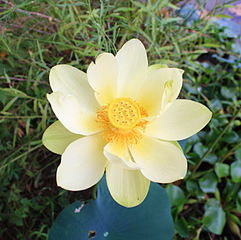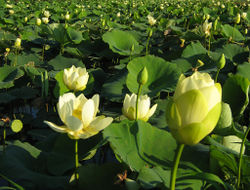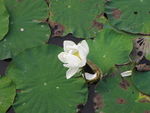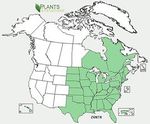American lotus
| American lotus |
|---|

|
| Scientific Classification |
|
| Scientific Name |
|
Nelumbo lutea |
| Image of American lotus thriving in its watery habitat |
The American lotus is a species of lotus known by the scientific name Nelumbo lutea. They live mostly in Eastern North America but can thrive in Eastern Canada also. It lives in swampy, wet areas, which is why it often makes it's home in the East. It is a very large plant, with large flowers and many petals, as well as large leaves.[2] The American lotus has many names; it is known as not only the American lotus but also the Yellow lotus, Yonkapin, Water Chinkapin, Chinquapin, Macoupin, and Wagipîn. Many of these names are of Native American origin, as the American lotus was the main source of food for many of the Native American tribes.[3]
Body Design
Once the American lotus is in bloom it has pale yellow petals and these petals surround the large, yellow seed receptacle which is coneshaped. [4] Typically, the American lotus can have anywhere between seven to twenty petals. The petals are usually large and aren't fused together. Along the stem, there is only one leaf from where the branch and the stem connect. The leaf blade has no teeth or lobes and is not separated into leaflets. The round leaves are a very dark green color. [5][6]
Since the American lotus is an aquatic plant, its roots have a foothold in the mud. The leaves can be up to two feet in diameter while each flower petal can only be up to 10 inches across. At the center of the flower where the yellow seed receptacle is, are the flower's seeds which can be up to 1.5 inches in diameter, which is actually quite small considering how big the actual flowers get. The plants themselves can grow to be up 3.5 feet tall![6]
Life Cycle
The American lotus lives in water so it has plenty of room to disperse and reproduce. The American lotus reproduce's through runners and seeds. If the flower lives in 75-85 degress weather for 2-3 months, it can reach huge sizes. The water that the flowers live in carry the seeds, that's why there are always such big colonies of the American lotus.[7] In spring, when the American lotus sprouts from its seeds; the leaf will begin to grow towards the surface. In summer, it grows rapidly. In the fall, in the American lotus' seed pods produce seeds that grow above the water’s surface. And in winter the American lotus isn't as present.[8]
Ecology
The American lotus is an aquatic plant. It is found in lakes, swamps, ponds, slow streams, and coastal plains. In order to survive, the American lotus needs lots of sun, loamy soil, and space. It is found mostly in Eastern North America because of it's sunny climates and wetlands; which is were it thrives best. [9] Both people and animals eats the American lotus. Almost every part of it is edible, but luckily there is an abundance of this plant so even though it is commonly eaten, it is in no danger of extinction. In addition, these plants grow very fast and can expand through many acres in a single growing season.[3]
The Edible Plant
The Native Americans used the American lotus as a food source. They would eat the roots, the flowers themselves, and their seeds. However, the root was the main thing that the Indians counted on to get them through the winter. This is still a tasty treat now and often animals will eat them too. However mostly people eat the seeds. Try keeping as eye out, you might find the Nelumbo lutea's seeds in your salad or the roots sliced up and fried next time you go to a restaurant. The seeds of this flower are so popular to eat that Nelumbo (which is Ceylonese) literally means "sacred bean."[10]
Video
Here are some facts about the American lotus
References
- ↑ NaturalResourcesConservationService Civil Rights at the Natural Resources Convervation Service. Accessed. May 14, 2017. Author Unknown.
- ↑ Nelumbo lutea Creative commons. Web. last modified date April 22, 2017.) Author unknown
- ↑ 3.0 3.1 Gettys, Lyn. American Lotus, Yellow Lotus: Nelumbo lutea Agronomy Department Extension. Web. Published March 2014.
- ↑ Williamson, Gerald. Wildflowers of the United States USDA Plants Database. Published. July 15, 2013.
- ↑ Nelumbo lutea Willd. New England Wild Flower Society. Accessed. May, 14 2017.
- ↑ 6.0 6.1 Robinson, Royce. American Lotus Department of Wildlife & Fisheries Sciences Texas A&M AgriLife Extension Service. Accessed. May, 14, 2017.
- ↑ Lotus, American Yellow Chicago Botanic Garden. Web. Accessed May 21, 2017.) Author Unknown.
- ↑ American Lotus Tennessee Valley Authority. Web. Accessed.May 21, 2017.) Author unknown.
- ↑ Hall, Thomas. The Biology of the American Lotus, Nelumbo lutea (Wild.) Pers The University of Notre Dame. Accessed. May 14, 2017.
- ↑ Deane, Green. American Lotus: Worth Getting Wet For Publisher site name.last modified. July 22, 2014.



